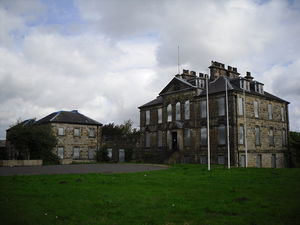Annotation:Cumbernauld House: Difference between revisions
No edit summary |
No edit summary |
||
| Line 3: | Line 3: | ||
|f_tune_annotation_title= https://tunearch.org/wiki/Annotation:Cumbernauld_House > | |f_tune_annotation_title= https://tunearch.org/wiki/Annotation:Cumbernauld_House > | ||
|f_annotation='''CUMBERNAULD HOUSE'''. AKA – "Cumberland House," "Cumernad House." AKA and see "[[Lord Aboyne's Welcome]]." Scottish, Air (4/4 time). G Major. Standard tuning (fiddle). AABB. Cumbernauld House [http://en.wikipedia.org/wiki/Cumbernauld_House] is a fine example of neo-classical architecture designed by fashionable architect William Adam and built for the Fleming family. It was completed in 1731. The last Lord Fleming, Earl of Wigton, died childless in 1747 and the estates passed to the Elphinstone family. Charles Elphinstone-Fleming, a retired Admiral, was laird from 1799–1840, and was for a time MP for Stirlingshire. [[File:cumberlnauld.jpg|300px|thumb|left|Cumbernauld House. (photo c. Steven Spier)]] | |f_annotation='''CUMBERNAULD HOUSE'''. AKA – "Cumberland House," "Cumernad House." AKA and see "[[Lord Aboyne's Welcome]]." Scottish, Air (4/4 time). G Major. Standard tuning (fiddle). AABB. Cumbernauld House [http://en.wikipedia.org/wiki/Cumbernauld_House] is a fine example of neo-classical architecture designed by fashionable architect William Adam and built for the Fleming family. It was completed in 1731. The last Lord Fleming, Earl of Wigton, died childless in 1747 and the estates passed to the Elphinstone family. Charles Elphinstone-Fleming, a retired Admiral, was laird from 1799–1840, and was for a time MP for Stirlingshire. [[File:cumberlnauld.jpg|300px|thumb|left|Cumbernauld House. (photo c. Steven Spier)]] | ||
<br> | |||
<Br> | |||
John (possibly Henry) Playford published the melody in 1687 in the fifth edition of '''Apollo's Banquet'''. The melody was used for the song "Where winding Forth adorns the vale", printed in James Johnson's '''Scots Musical Museum, vol. II''' (Edinburgh, 1788, Song 142, p. 149). The words by Scots poet Robert Ferguson<ref>Although Ferguson died young, poet Robert Burns admired his work and caused a stone to be erected in the | |||
Canongate Churchyard, where he is buried.</ref> (1750-1774) begin: | |||
<blockquote> | |||
''Where winding Forth adorns the vale,''<br> | |||
''Fond Strephon once a shepherd gay,''<br> | |||
''Did to the rocks his lot bewail,''<br> | |||
'And thus addresst his plaintive lay.''<br> | |||
'O Julia, more than lilly fair,''<br> | |||
''More blooming than the op'ning rose,''<br> | |||
''How can thy breast relentless wear.''<br> | |||
''A heart more cold than winter's snows.''<br> | |||
</blockquote> | |||
|f_source_for_notated_version= | |f_source_for_notated_version= | ||
|f_printed_sources=Francis Barsanti ('''Collection of Old Scots Tunes'''), Edinburgh, 1742; p. 6. | |f_printed_sources=Francis Barsanti ('''Collection of Old Scots Tunes'''), Edinburgh, 1742; p. 6. | ||
Revision as of 06:30, 11 March 2024
X:1 T:Lord Aboyne’s welcome or Cumbernauld house M:C L:1/8 R:Air Q:”Slow” B:Francis Barsanti – “Collection of Old Scots Tunes” (Edinburgh, 1742, p. 6) F: https://vmirror.imslp.org/files/imglnks/usimg/b/b0/IMSLP94625-PMLP194938-Barsanti_A_Collection_of_Old_Scots_Tunes.pdf N:Francis Barsanti (1690-1775) was an Italian flautist, oboist and composer who spent N:most of his life in London and Edinburgh. Z:AK/Fiddler’s Companion K:G V:1 G>A|B>AB>d {c}B2 (AG)|E>DEG A2 B>d|e2 (d>c) d(BTAG)|(D>E)(G>A) G2:| |:TB>A|G>AB>c {Bc}d3e|Td(c/B/) AB d2 zd|e>fg>a Tf2 (g/f/e/d/)|B2 e>f Te3d| g>a (g/a/b) B2 (c/B/TA/G/)|AB {e}d(c/B/) A2 B>d|Te2 d>c d(BTAG)|(D>E)(G>A) G2:|] V:2 clef = bass z2|G,,2D,2G,2 zB,|C3G,D,2G,,2|C,>CB,>A, B,,2C2|D2D,2G,2:| z2|G,2 G,>A, B,>A,B,>C|B,2 zG, D,DB,G,|C,2 z^C, ^D,B,,E,A,|B,2B,,2 E,EDC| B,,2 zD, G,2 zG,,|C,2G,,2D,2G,,2|C,>CB,>A, B,2C2|D2D,2 G,2:|]

John (possibly Henry) Playford published the melody in 1687 in the fifth edition of Apollo's Banquet. The melody was used for the song "Where winding Forth adorns the vale", printed in James Johnson's Scots Musical Museum, vol. II (Edinburgh, 1788, Song 142, p. 149). The words by Scots poet Robert Ferguson[1] (1750-1774) begin:
Where winding Forth adorns the vale,
Fond Strephon once a shepherd gay,
Did to the rocks his lot bewail,
'And thus addresst his plaintive lay.
'O Julia, more than lilly fair,
More blooming than the op'ning rose,
How can thy breast relentless wear.
A heart more cold than winter's snows.
- ↑ Although Ferguson died young, poet Robert Burns admired his work and caused a stone to be erected in the Canongate Churchyard, where he is buried.

